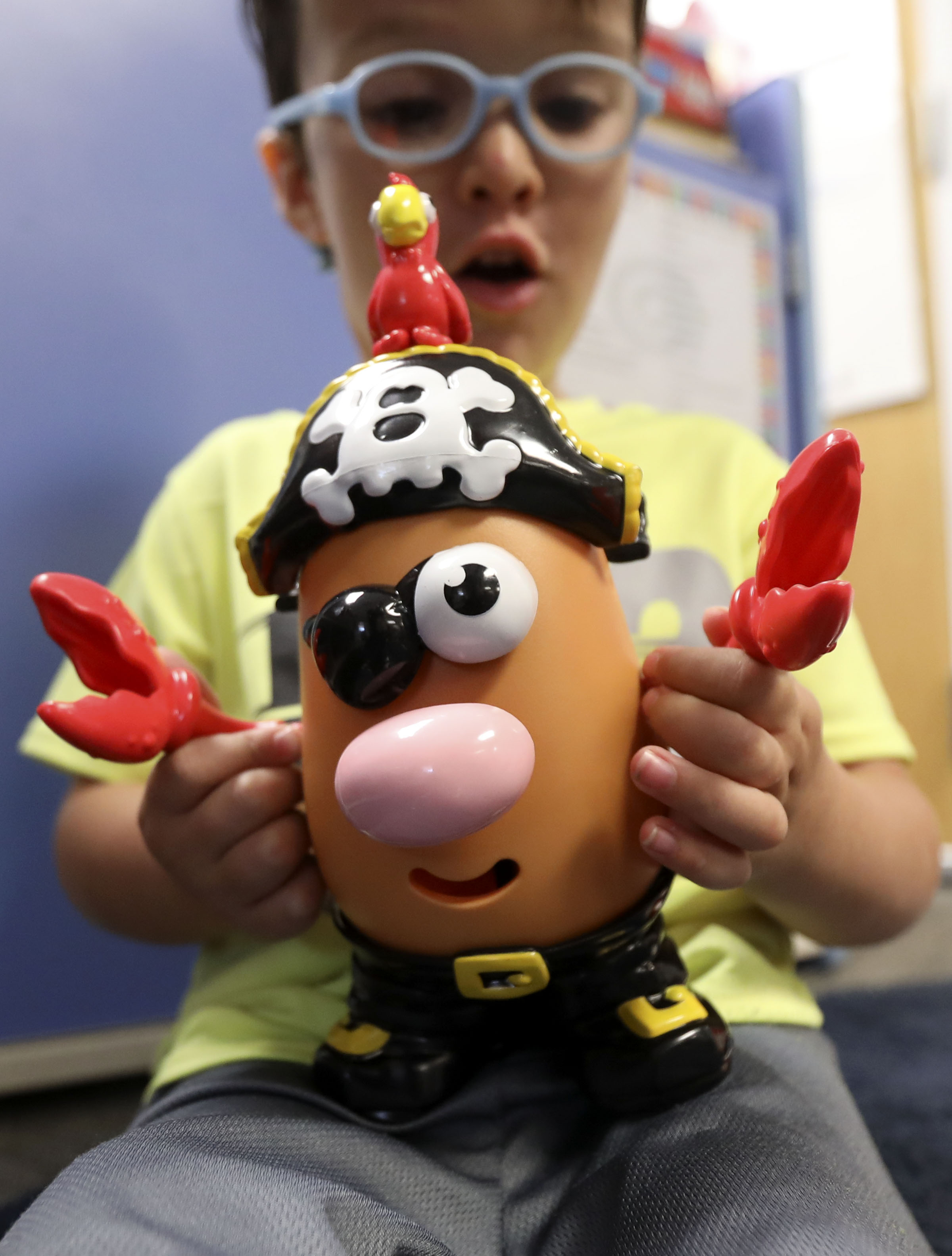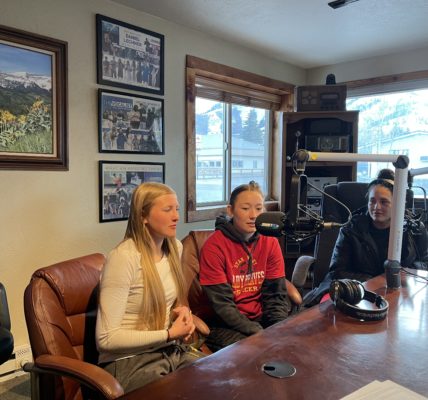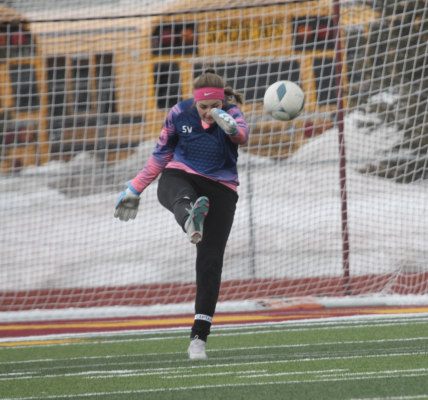Programs that foster hope and life skills help kids avoid violence and reach goals
On a summer midweek morning, some of Utah’s youngest learners — preschoolers — crowd into a play kitchen at the Utah Community Action Head Start to make a colorful fake pizza, which they “feed” to Mike Varanakis, the organization’s spokesman.
The children, ages 3 to 5, consult each other as they decide on an imaginative combination of toppings. Grapes get the starring role.
Soon they’ll sit down to real food with program staff, family style, and the conversation will perhaps include some fun facts about what’s on their plates, with a tidbit or two about nutrition deftly folded into chatter about what each child did the night before. Lunch here is more than a nutritious meal. It’s also a chance to expand vocabularies, practice social skills and hone ability to manage utensils, feeding young bodies, but also young minds.
The program is one of many designed to give low-income kids a boost, not just academically, but in life. Such programs may especially target reading and understanding basic STEM concepts. They encourage creativity and forge life skills. But one of the most stunningly important gifts under construction in worthwhile child-focused programs is what social scientists call “positive future orientation.”
Hope and goals. The programs help parents build kids who feel ready to meet a bright future. That’s something every child needs.
Multiple studies suggest when kids are optimistic and expect to accomplish good things, they make choices that protect their futures. Positive future orientation has been associated with desirable outcomes like better school engagement and more successful transition to adulthood. Future-oriented teens are less likely to commit crimes or use drugs and alcohol. They’re more likely to stay in school.
The list of positives for young people with an optimistic sense of the future keeps growing as studies find new benefits. Just this month, researchers at the University of Pittsburgh published the finding that hope and aspiration should be high on the list of ingredients for youth violence-prevention programs. It’s a protective factor that makes adolescent males less inclined to perpetrate violence, says Dr. Alison J. Culyba, a pediatrician who led the study, highlighted in a research letter published July 2 in JAMA Pediatrics.
The study said teens who expect good things in their future were less apt to have threatened or injured someone with a weapon in the past nine months, though they were no less likely to have been in fights.
It’s another mark in the win column for families and programs trying to foster in kids both resilience and hope.
Under construction
A few miles away from Utah Community Action Head Start, kids ages 7-18 snag a Kids Café meal at the Sunnyvale Neighborhood Center, run by the Asian Association of Utah. It, too, primarily serves a low-income population and has carefully curated activities that are part of an evidence-based curriculum that has been proven to teach kids while it engages them. Sometimes the learning is subtle, but the children are building layers of skills so they’ll do better in all aspects of life, from school to jobs to relationships.
The center opened initially to serve nearby refugee and immigrant families as they acclimated to new lives in America. It offered English as a Second Language for adults and academic help to children, often folded into play. Like the Head Start program, it also provided nutritious meals to kids in limited-resource families, says Peter Frost, center manager. Over time, everything about the program expanded, from the services offered to the facility itself.
These programs and others are intentional as they guide their charges toward positives and protect them from negative influences that could hamper them on their way to adulthood. For instance, says Frost, refugee children sometimes feel out of place, which makes them targets of gang recruiters. So programs focus on factors that protect kids.
Education protects. So does strong community connection. After-school and summer programs do, as well, Frost says, providing a “positive place to be” at stages when children are most vulnerable to negative outside influences.
That’s not yet a concern at programs like Head Start, which serve children who are very young. They just need the strongest base possible. Chief development officer Joni Clark notes the program even offers some services before children are born, like making sure that qualified pregnant women receive prenatal care to give babies a healthy physical start. The benefits accrue throughout childhood and beyond. What the preschoolers learn can help them in grade school, setting them up for long-term academic success. With that foundation, they’re more apt to thrive as adults.
Jared Lisonbee, Utah Community Action research analyst, traces unexpected connections between activities and a child’s future life. Almost any topic of conversation — say food or the family dog — can build vocabulary, “key to reading and learning success.” Using a glue bottle to make art also builds motor skills kids will need to control writing instruments in school.
Even “slime” unexpectedly multitasks. Squishing it strengthens a child’s forearm. The goo can be shaped into letters. Making a bubble and popping it builds childish knowledge of cause and effect, he says. “It’s not just playing.”
Lisonbee notes that even gazing out the window at trees and bushes and spotting birds and insects, or seeing how long shadows are, broadens what kids know. Knowledge makes children feel confident and capable, directly impacting how they see their futures and influencing their choices and opportunities.
The research on violence
The research on violence prevention is exciting, says Culyba, who is also an assistant professor of pediatrics at the University of Pittsburgh School of Medicine. “There have been really well-designed studies looking at a lot of outcomes related to how kids do in school and whether or not they’re involved in risky behaviors like using illicit substances. Other studies have really shown that future orientation is an important protective factor across a lot of health indicators for adolescents. That motivated us to ask whether positive future orientation might also protect youths from being involved in violence.”
Culyba says fights are incredibly common in the low-resource Pittsburgh communities where she and her colleagues recruited 866 male teens for their study through community agencies that serve youths. They asked about fighting in general terms, not about specific roles, so being in a fight could include being victims or witnesses, not just aggressors.
The finding “suggests that designing intervention programs to help recognize and support a positive future orientation especially among youths living in lower-resource urban communities may be a really important part of violence-prevention intervention programs,” Culyba says.
Preventing violence is not an idle goal. The National Center for Injury Prevention and Control’s Division of Violence Prevention says 1 in 5 high school students are bullied each year. Homicide is the third-leading cause of death for those ages 10-24 and nearly 1,400 youths are treated each day in emergency departments nationwide for injuries from assaults. Those youth homicides and assaults cost an estimated $18.2 billion a year in medical costs and lost productivity.
All the Pittsburgh participants were male. Three-fourths were African-American, 8 percent were multiracial, 4.4 percent were American-Indian/Alaska Native, and just under 4 percent each were white or Asian. The youths were asked seven questions to discover their attitudes about the future. They included “I am excited about my future,” and “my life will make a difference in the world.”
“African-American male youths in low-resource urban neighborhoods bear a disproportionate burden of violence exposure and involvement,” the study notes. “Identifying promotive factors is essential for designing interventions that recognize the strengths of young people and marshal those strengths to protect youths.”
Culyba says this was a one-community study, so it’s impossible to know from this research alone if the same findings would be true with other populations, or in other communities. That’s a common limitation of research studies, but probably no more limiting than for any study, she adds. “It is important that we do future studies among diverse populations across the U.S. to confirm that the results are similar.”
The study didn’t show causation, but she says it’s likely teens who are goal-oriented and hopeful are less apt to engage in violence with weapons because that could lead to consequences that could thwart their future plans.
While most research on teen violence focuses on risk factors and the Pittsburgh study considered protective factors, the Centers for Disease Control and Prevention has gathered data on both.
It notes that individual risk factors associated with youth violence include having been victimized in the past, attention and learning challenges, low IQ, substance abuse, a history of early aggression, poor behavior control and emotional problems, to name several.
There are family risk factors, too, many of them stemming from how parents interact with their children or conduct their own lives. For instance, parents who show little warmth but discipline harshly, those who abuse substances or commit crimes, parents with little education and dysfunctional relationships are all among those more likely to have children who hurt others, according to the CDC.
Hanging out with delinquents, being rejected by peers, failing in school, family disruption and not being involved in the community also may ramp up the risk of violence, CDC says.
Known factors that protect young people from violence include high intelligence, academic achievement, solid relationships, religiosity, strong family connections, consistent and positive parenting and belonging to peer groups that eschew antisocial behavior, among others, according to the CDC’s research review.
Those are precisely the kinds of positives that programs to help children try to instill, whether by giving kids who might otherwise be disadvantaged a little extra help or providing skills guidance and resources to parents who could use a hand.
Building a future
Encouraging teens to dream and believe in the possibilities of their futures won’t overcome all challenges, Culyba says. Her body of research suggests it’s also vital to provide community resources so teens “actually have the opportunity to make good on their goals and hopes.”
Frost and Varanakis talk about the importance of nurturing goals, too, if kids are to find a future-enhancing path.
Culyba offers examples that help teens, like youth development or job training programs that connect them with chances to experience and learn about career paths that interest them. A youth interested in social media and technology, for example, could be linked to a start-up company that works in that space, providing opportunities to explore it as a career path, she says.
“Ideally, opportunity could be very individualized so teens who express an interest could be connected with chances to build those skills and support others within their community,” she adds.
Among her earlier research was a study showing that well-maintained neighborhoods with good public transportation, parks and other modifiable features were associated with “lower odds of homicide” among teens.
Head Start actively builds on a family’s strength and protective factors, says Christine McAtee, health and family partnership manager, who touts a robust curriculum that ranges from child-protection concepts like pedestrian safety and good touch/bad touch to social-emotional problem solving and basics like the importance of sharing. “Kids need all those things to build self-esteem and help socialize them in a productive way.”
Adds Clark, “Being in poverty is a very difficult thing to experience. It’s important for our program and others to wrap services around families and support them and give them what they need.”
Studies are clear what they need includes goals — and confidence they can reach them.
Email: lois@deseretnews.com, Twitter: Loisco
![]()





